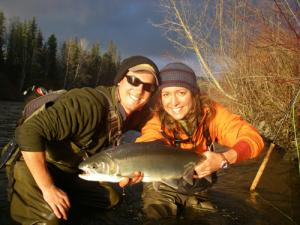Bringing People Together to Save Endangered Salmon
Our project works to save wild salmon by creating a collaborative forum that puts salmon restoration in the hands of scientists and those impacted by their survival, not just politicians.
About the project
The Save Our wild Salmon Coalition is working on a collaborative approach to save endangered salmon in the largest, most-intact salmon watershed in the United States: the Columbia-Snake River Basin.
The wild salmon and steelhead of the Columbia and Snake Rivers have swum our rivers and oceans since the time of dinosaurs. Swimming farther and higher than any other migrating fish, the rivers in our backyard also once boasted one of the largest salmon populations on Earth. Salmon are a cultural icon, an economic resource, a healthy food source, and a way of life for communities from California to Alaska.
But the wild salmon of the Columbia and Snake are now endangered with extinction, due to dams and other human actions. Federal management of salmon has failed to follow the science and has been ruled illegal in court four straight times. Tribes, fishermen, and conservationists have fought for and won several measures that have helped salmon but it is not enough to avoid extinction for these fish. Stakeholders in the watershed must sit down and talk through the available alternatives to the four deadly and outdated dams on the lower Snake River.
The Nez Perce Tribe and the State of Oregon – along with fishermen, conservationists, and businesses – have proposed a new approach: a collaborative forum that brings everyone together to build shared solutions based on science.
Our project will help begin this much-needed new approach before it’s too late.
The Steps
This project has three steps:
(1) Create a series of short videos featuring those impacted most by salmon survival in the Snake River including tribes, farmers, fishermen, and tourism businesses. We will distribute these videos nationally to bring attention to this critical issue.
(2) Create a series of short videos with key salmon scientists. Thanks to science, we know more now about how to restore salmon than we did a decade ago. Scientists will outline what is working and what else must be done to save wild salmon.
(3) Organize visits around the Northwest and in the Nation’s Capital with fishermen, business leaders, Tribal leaders, and scientists. On these trips, stakeholders can talk directly with our elected leaders and the media.
Why we‘re doing it
Salmon need our help. Collaborative forums where people talk and work directly with one another are getting results on tough issues like this one nationwide. On the San Joaquin River in California, the Klamath River in Oregon, and the Penobscot River in Maine, rivers are being restored, jobs created, and communities enriched.
Bringing people together is not easy- it takes time, education and outreach. But we can get there with your help! Our project will facilitate this process by helping to bring stakeholders together to find common ground through new educational materials and face-to-face meetings across the Northwest.

